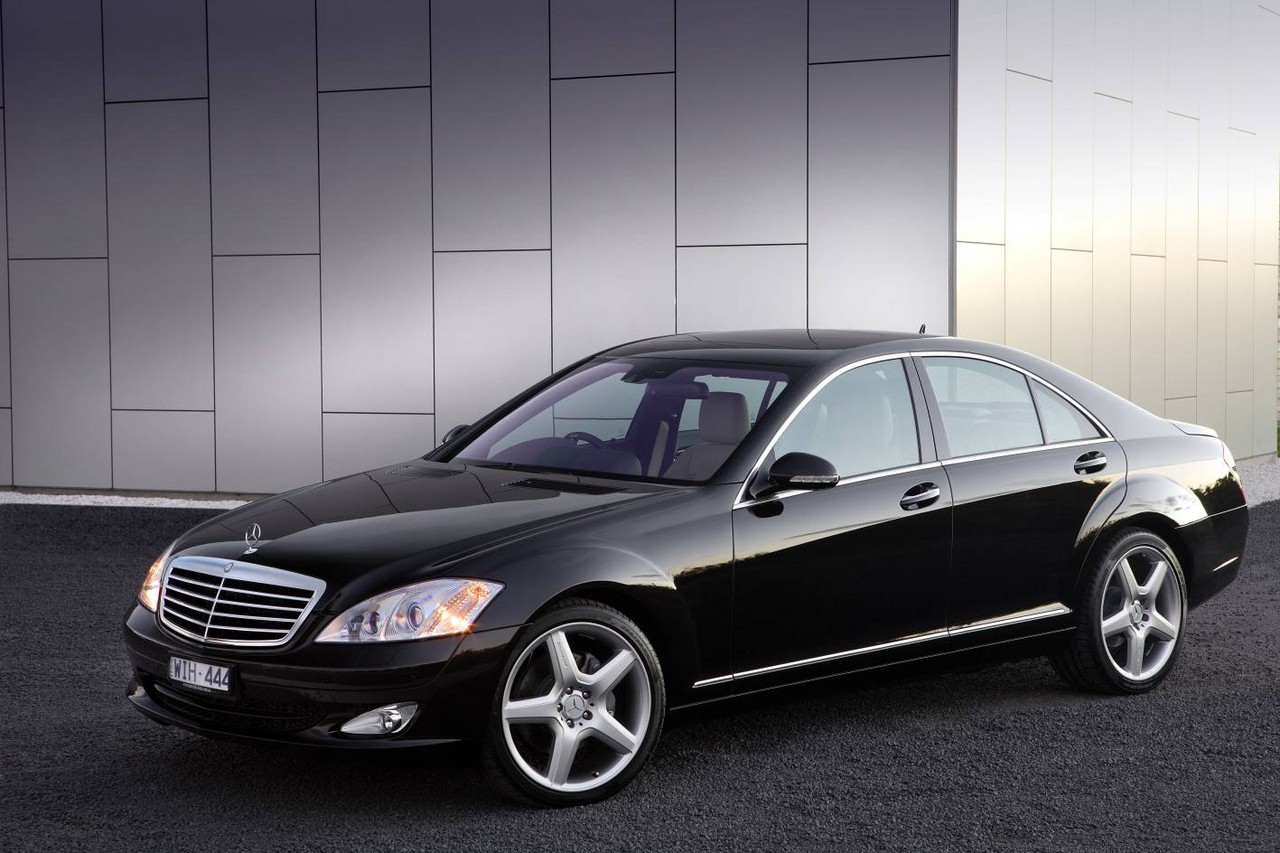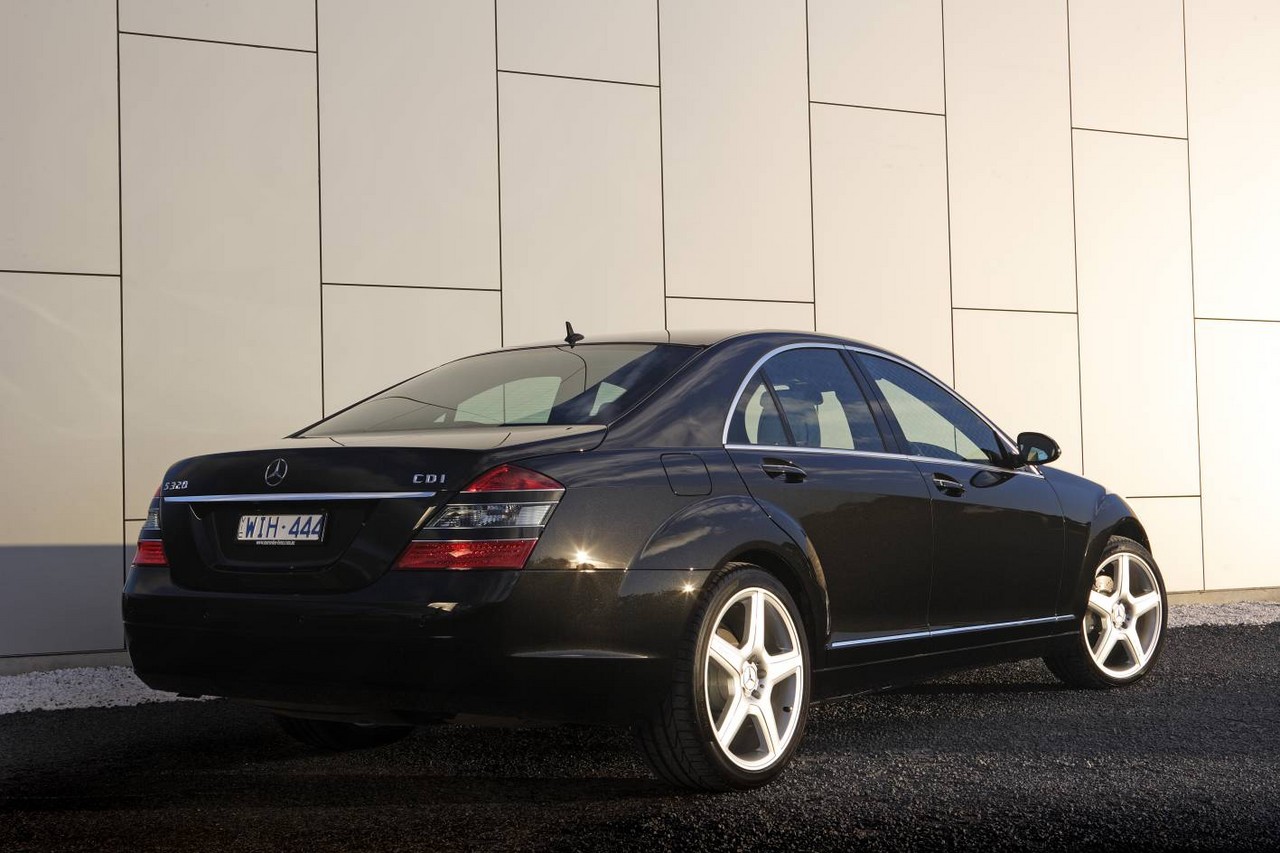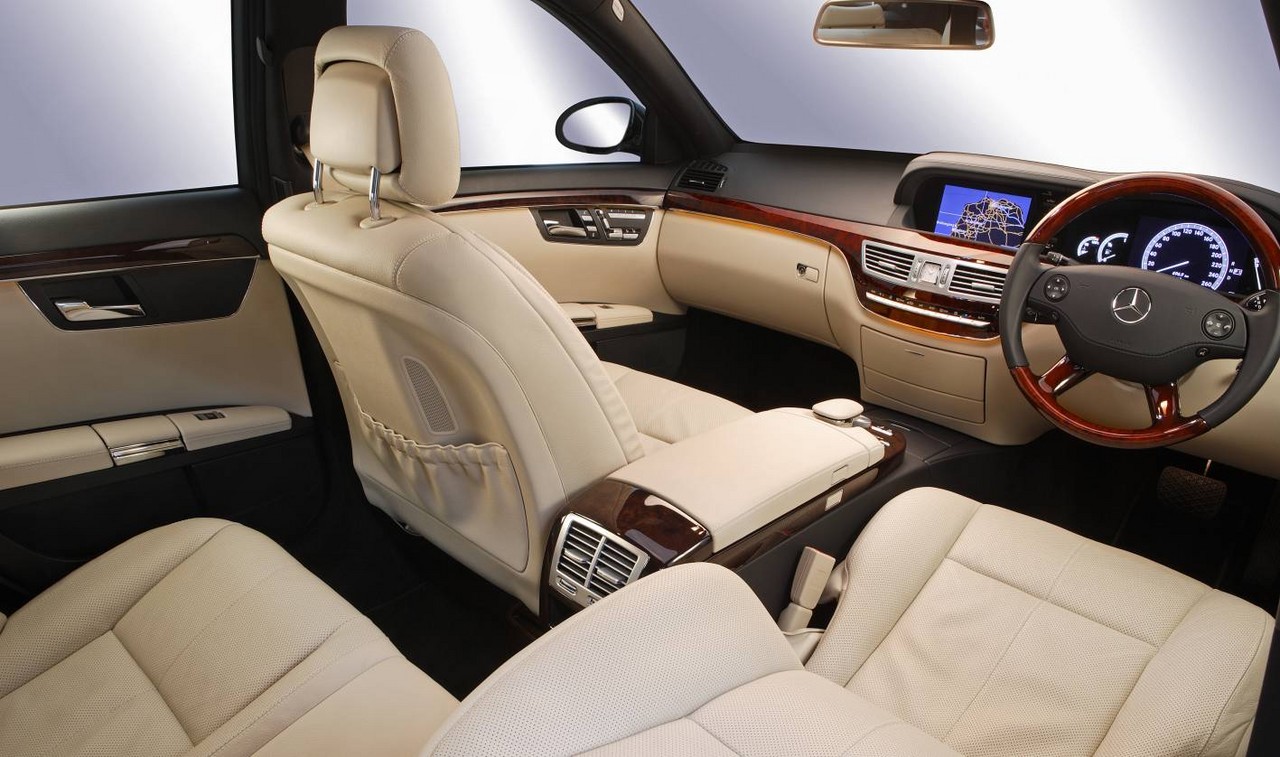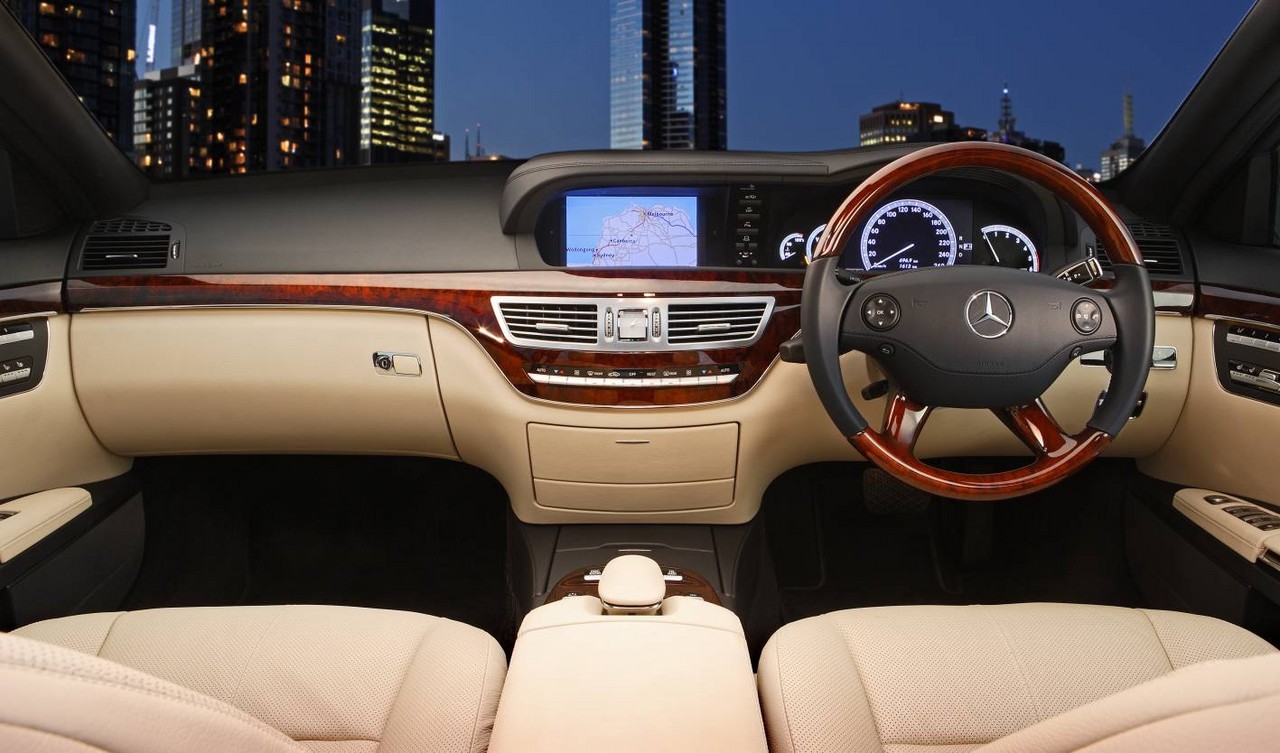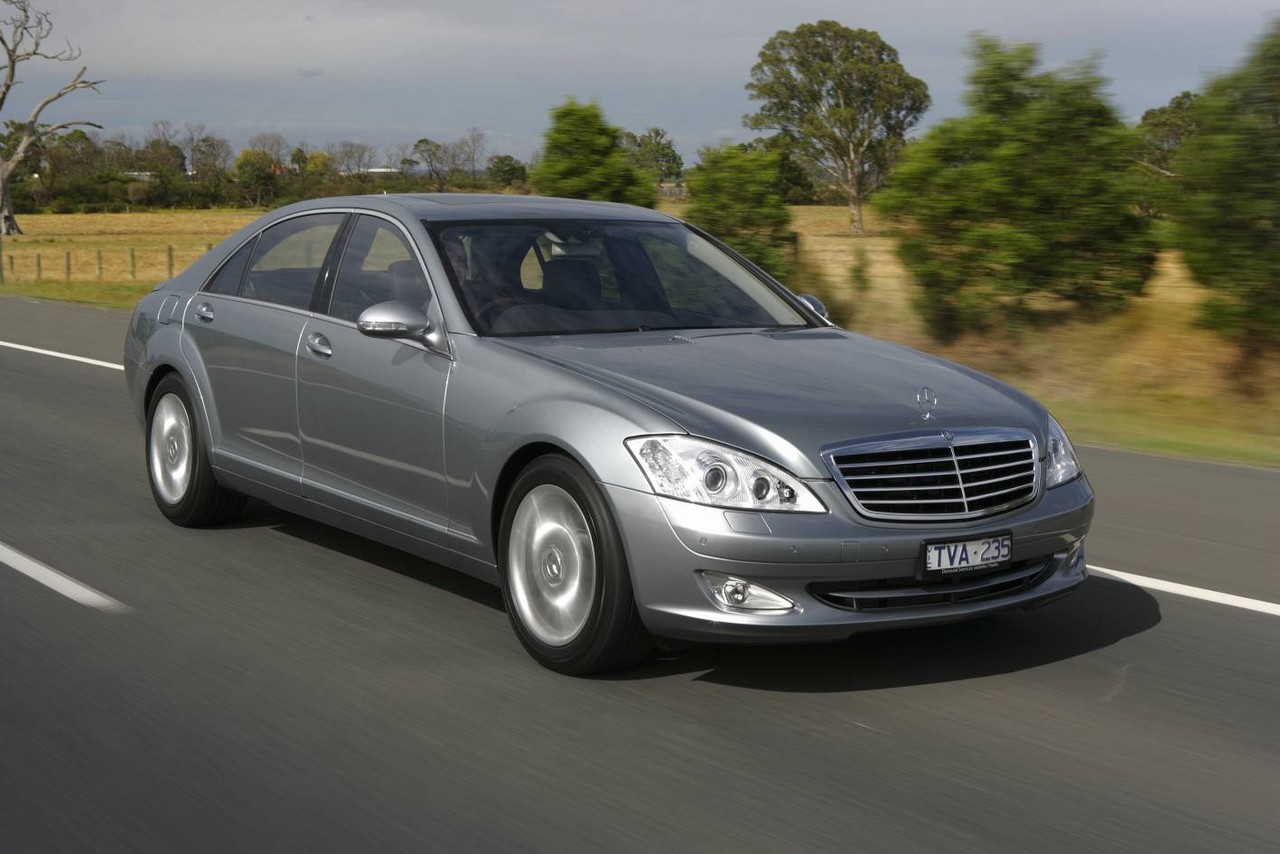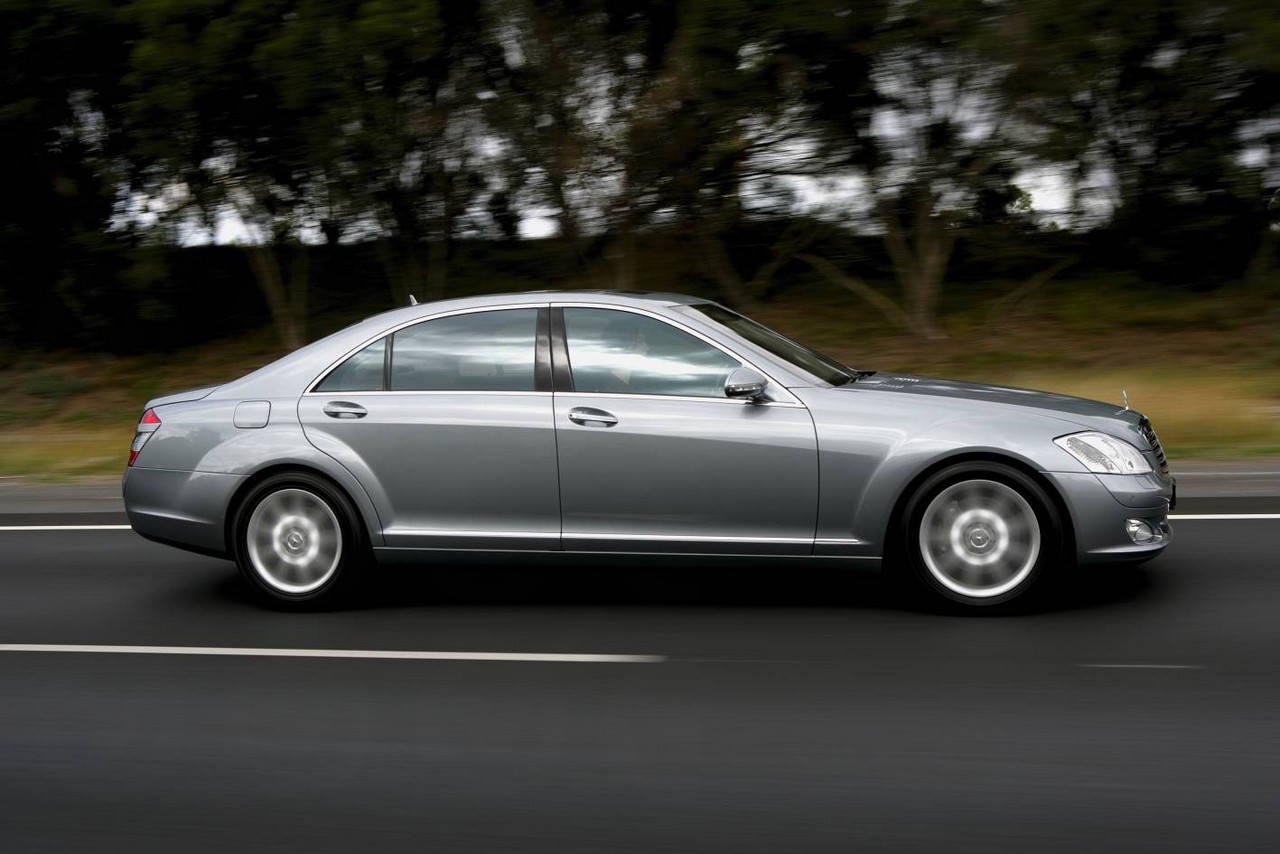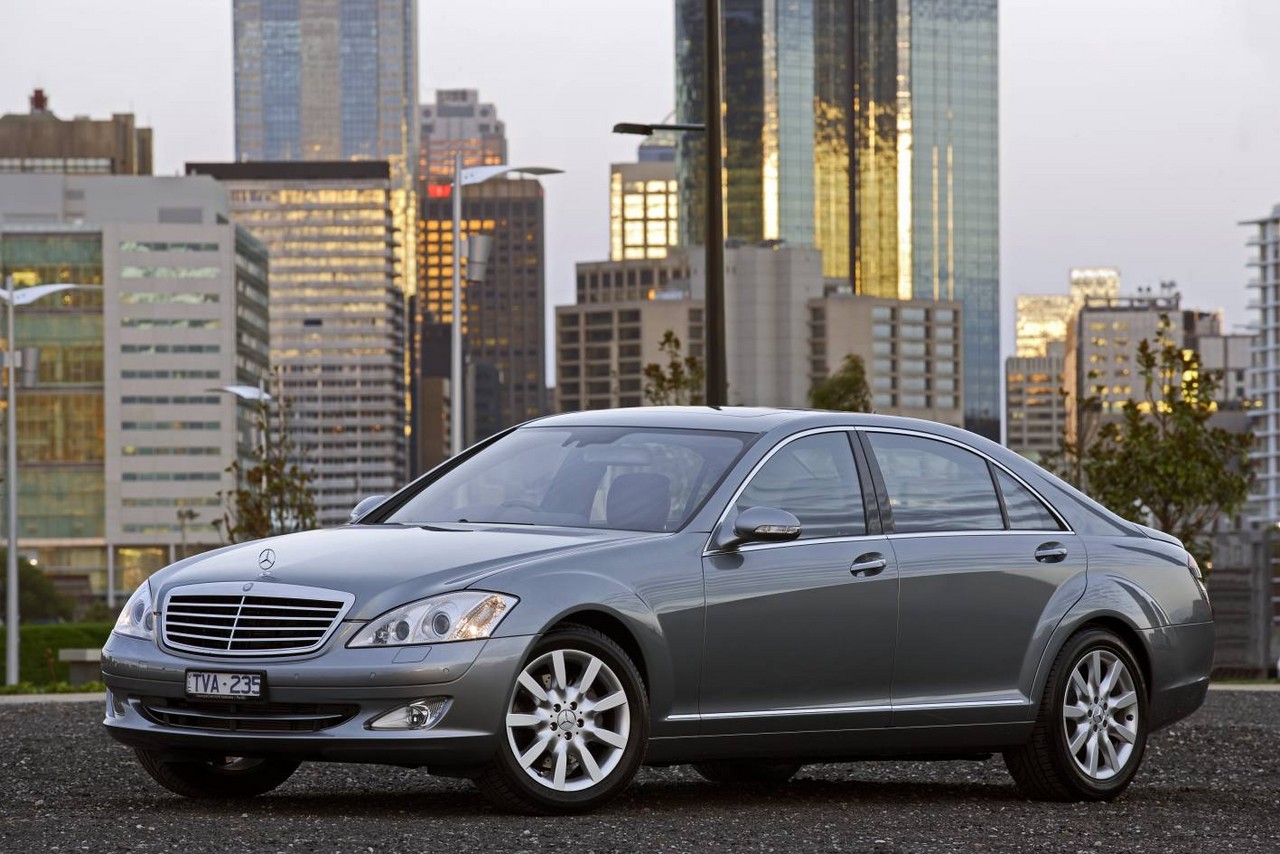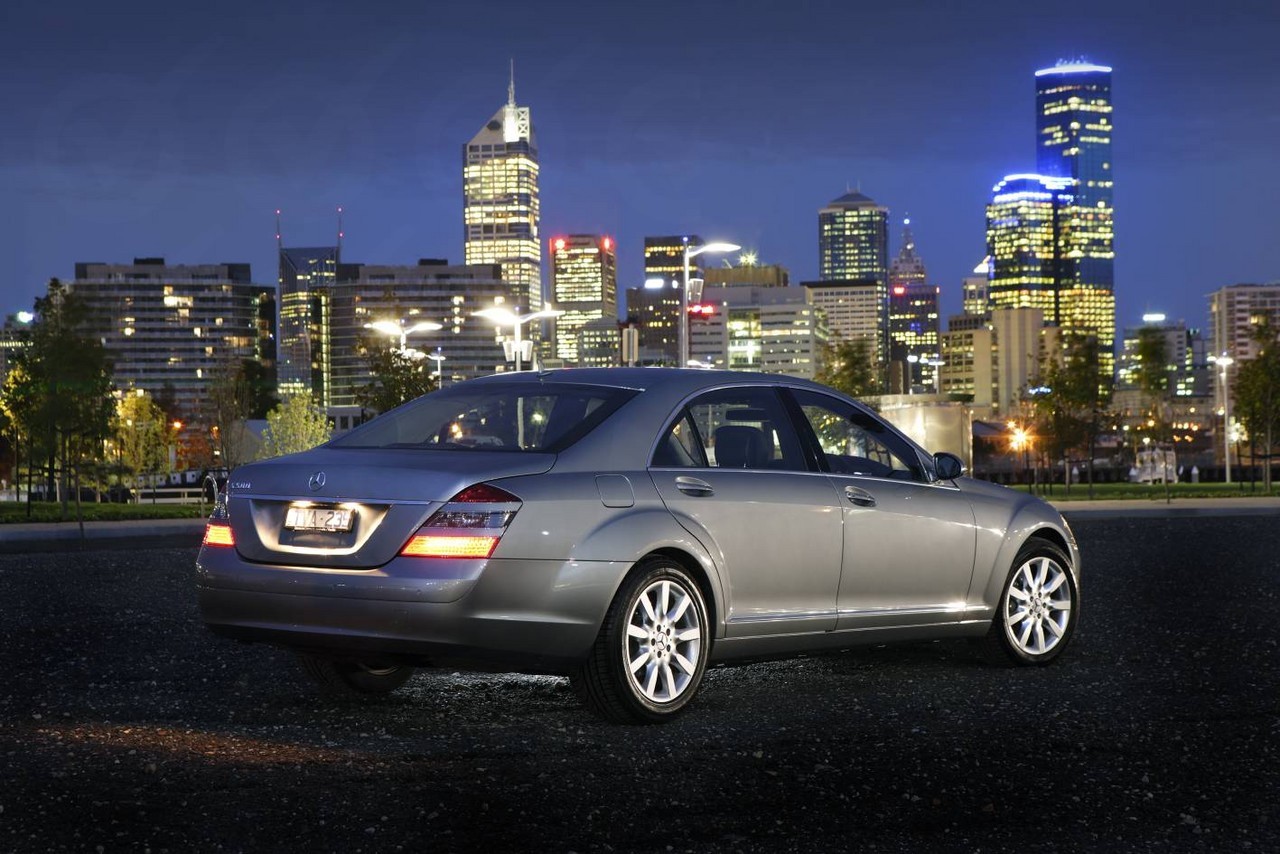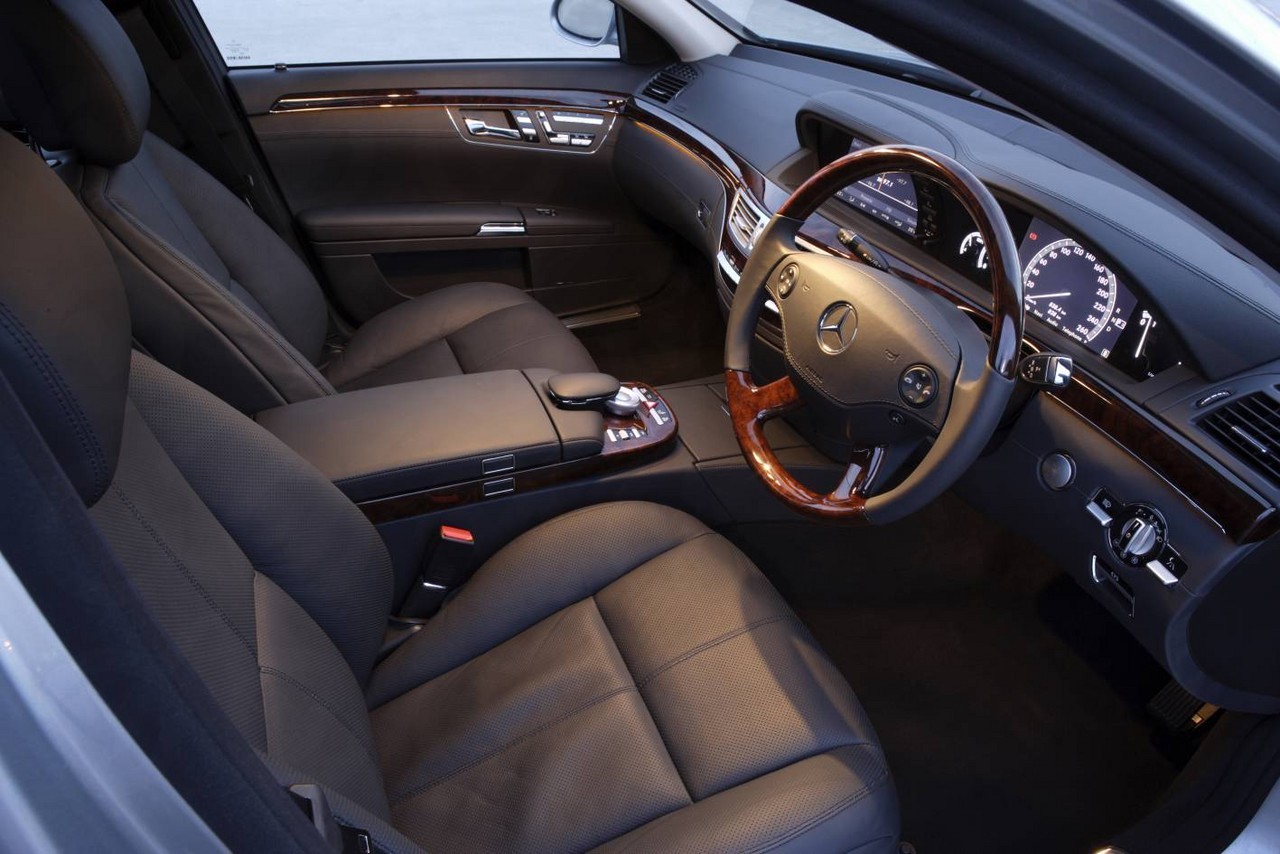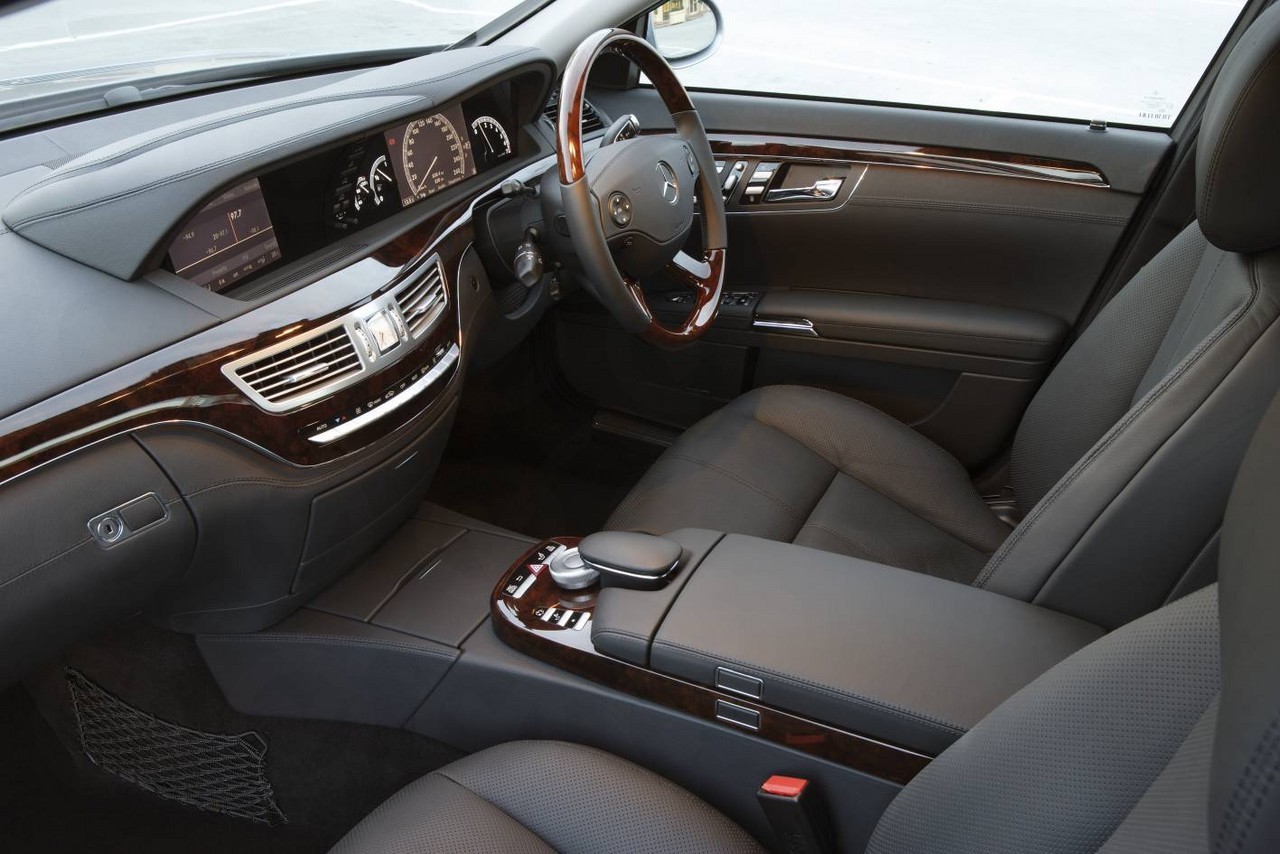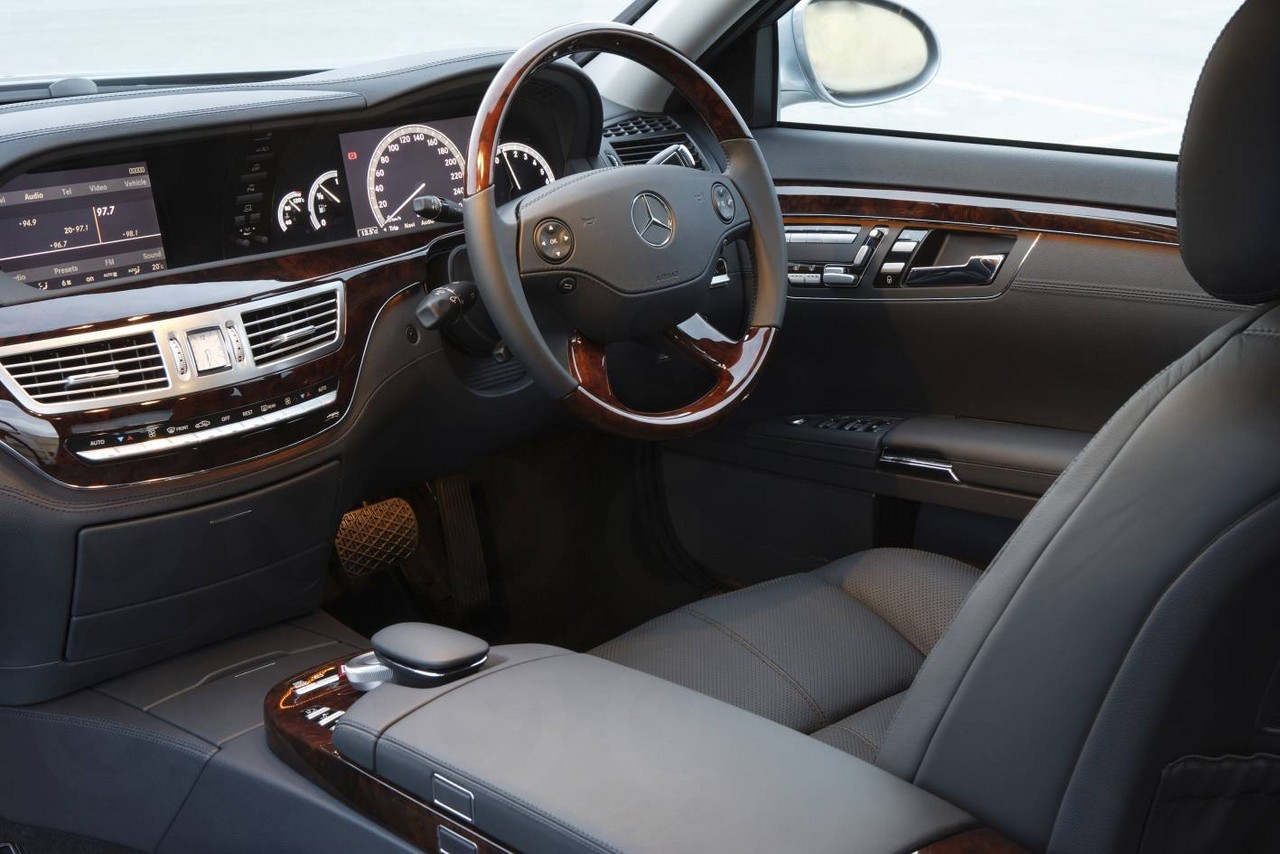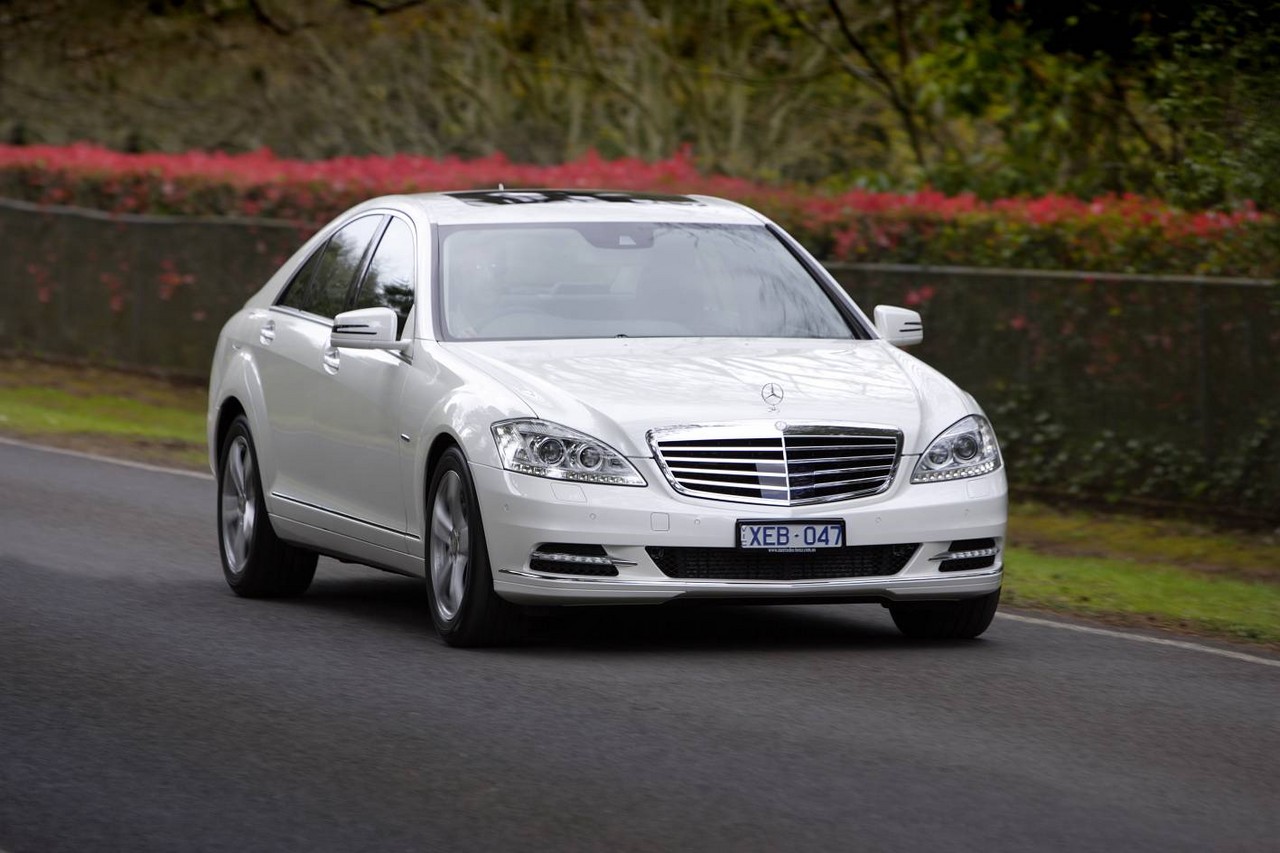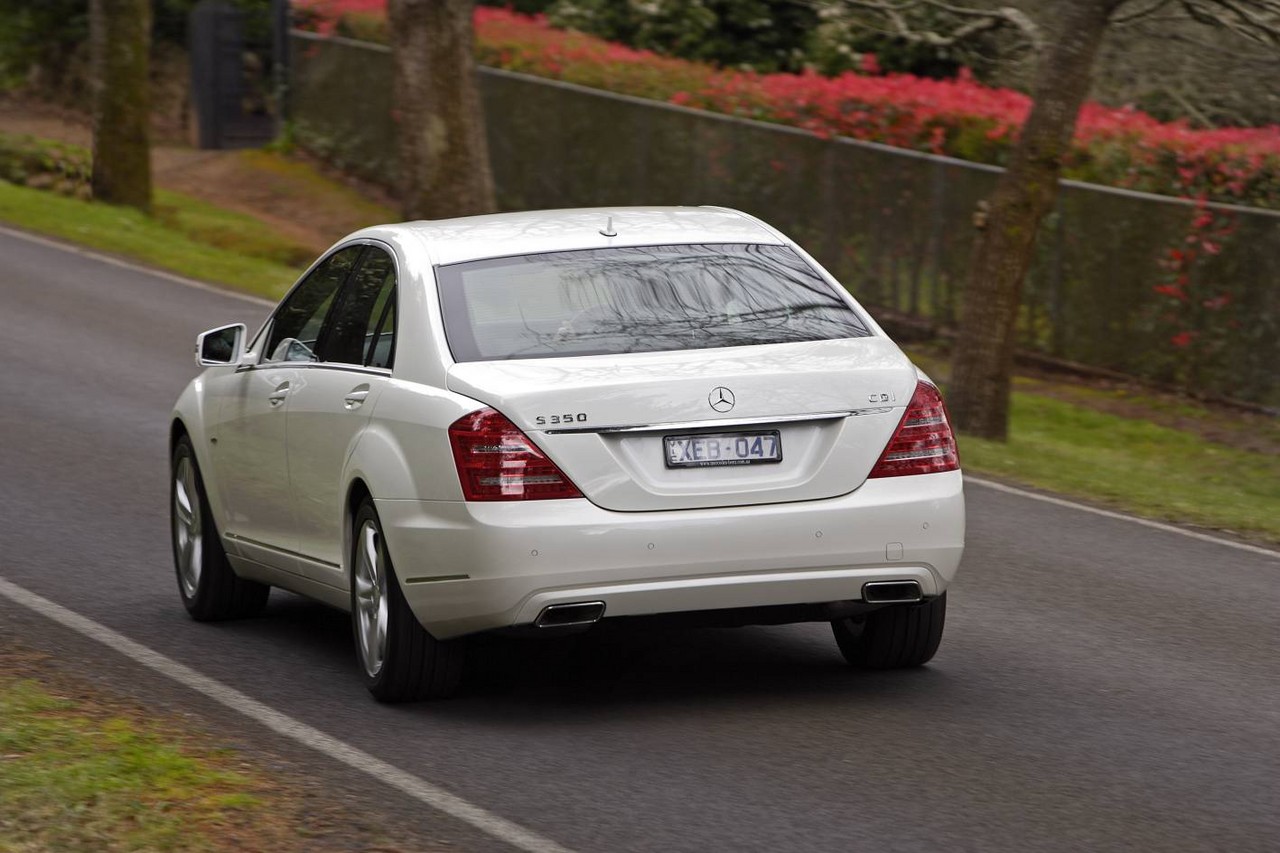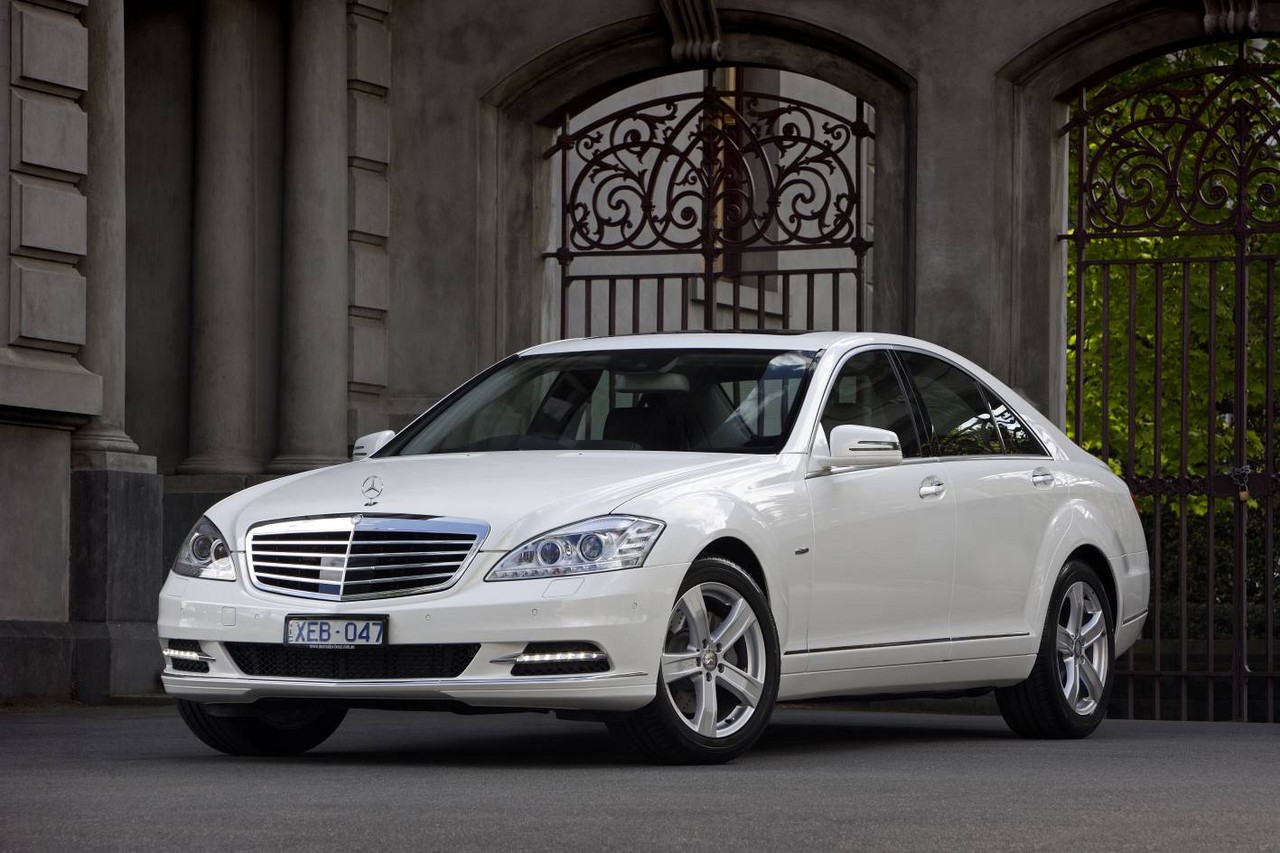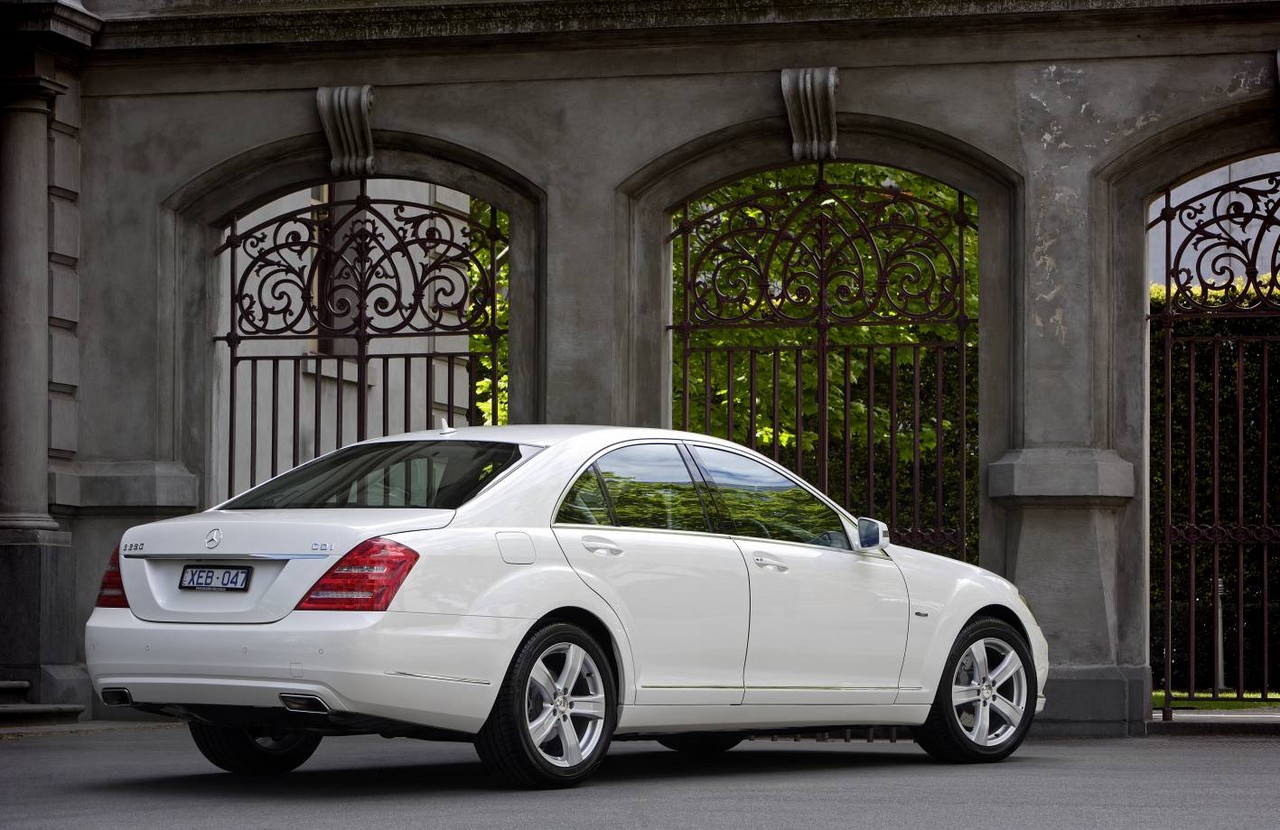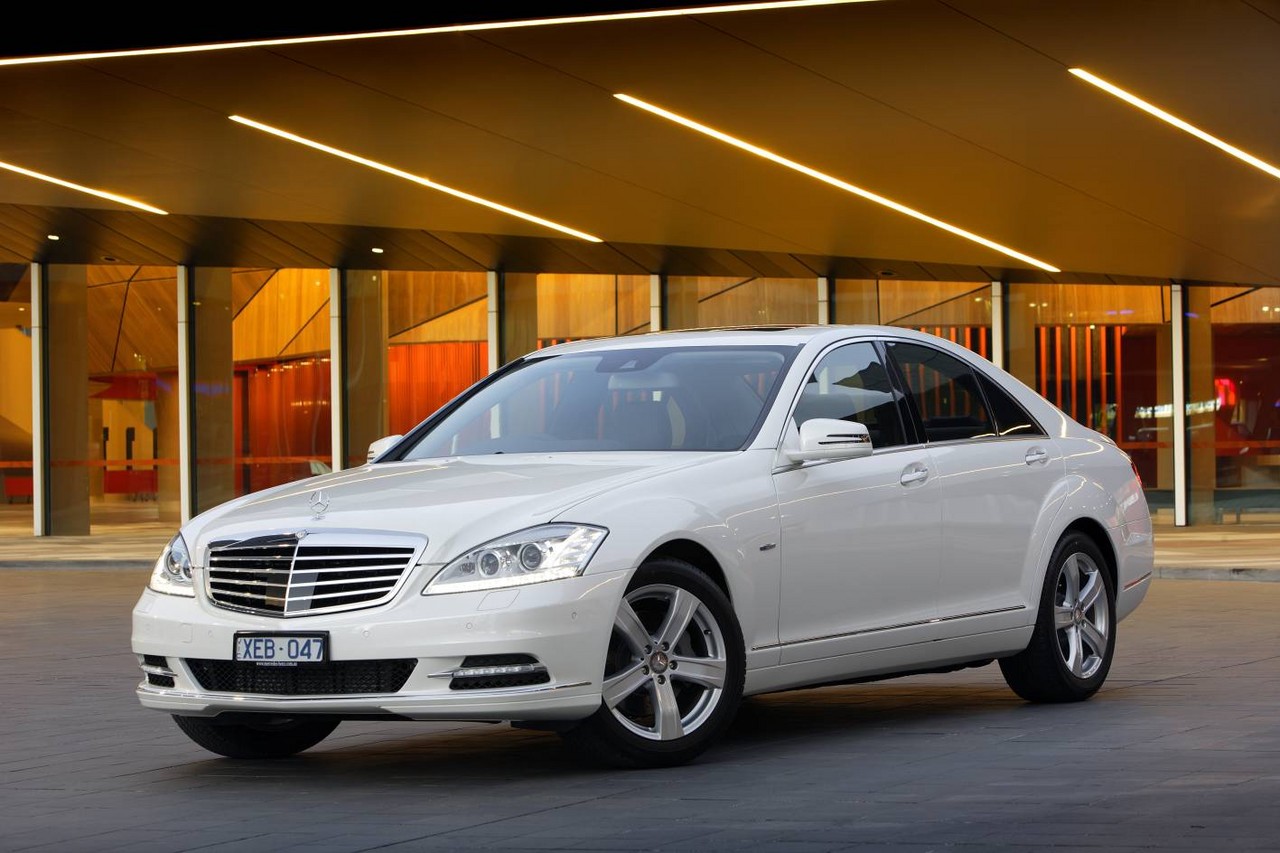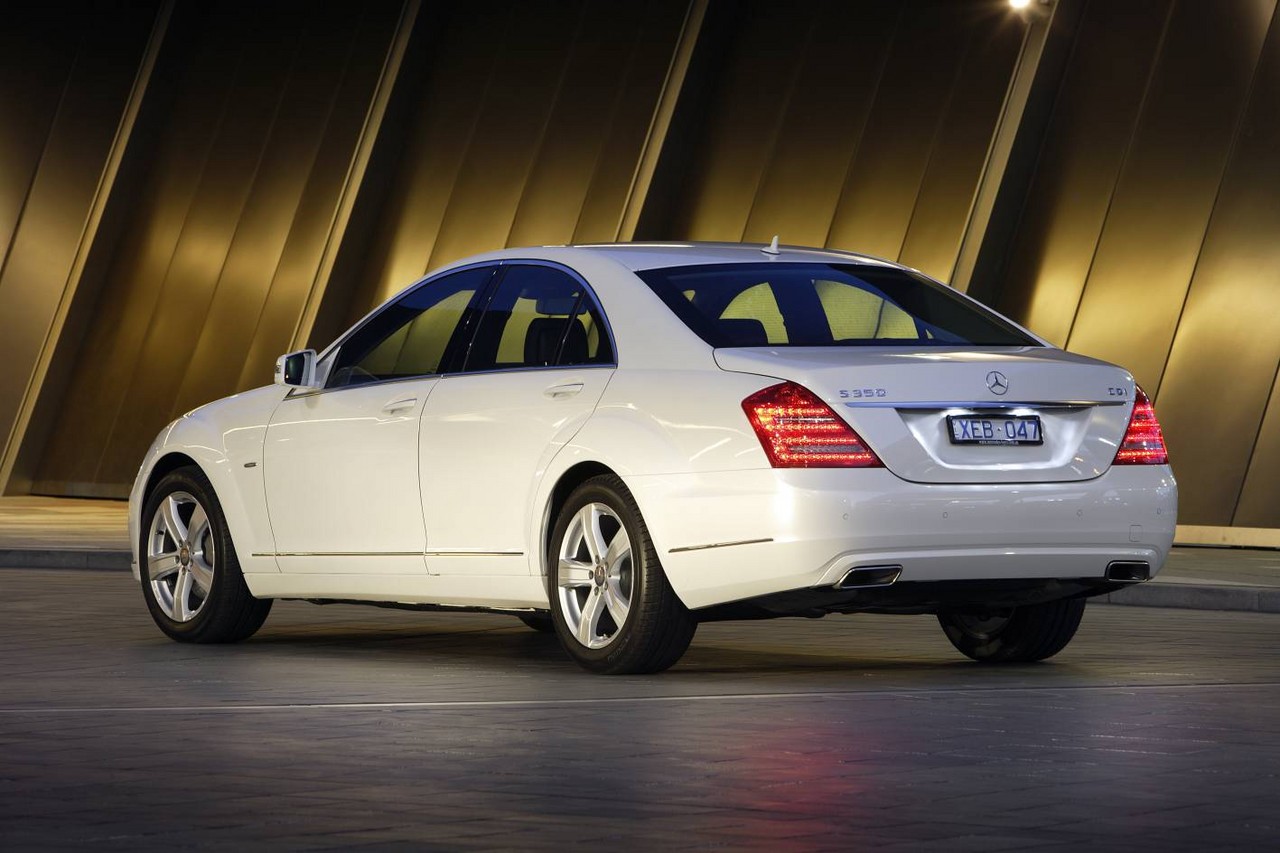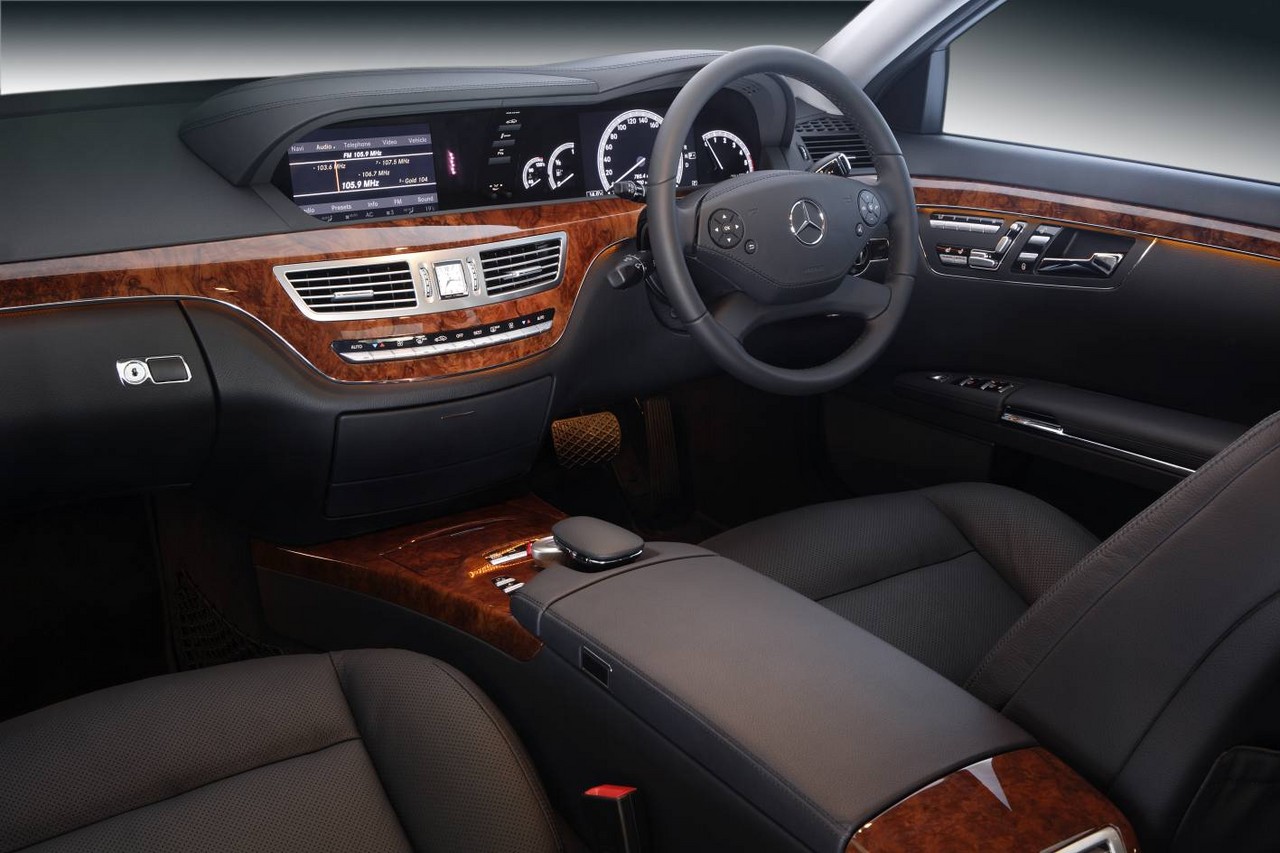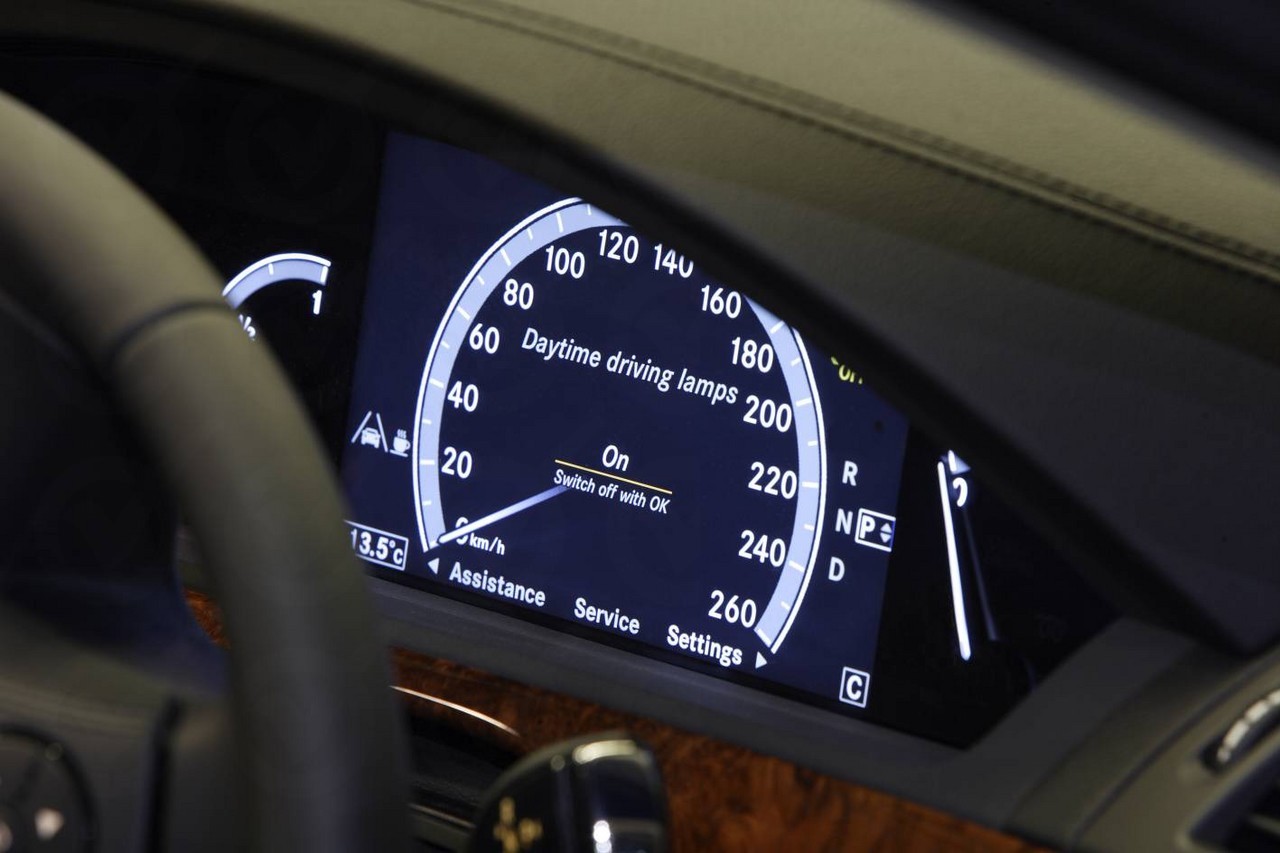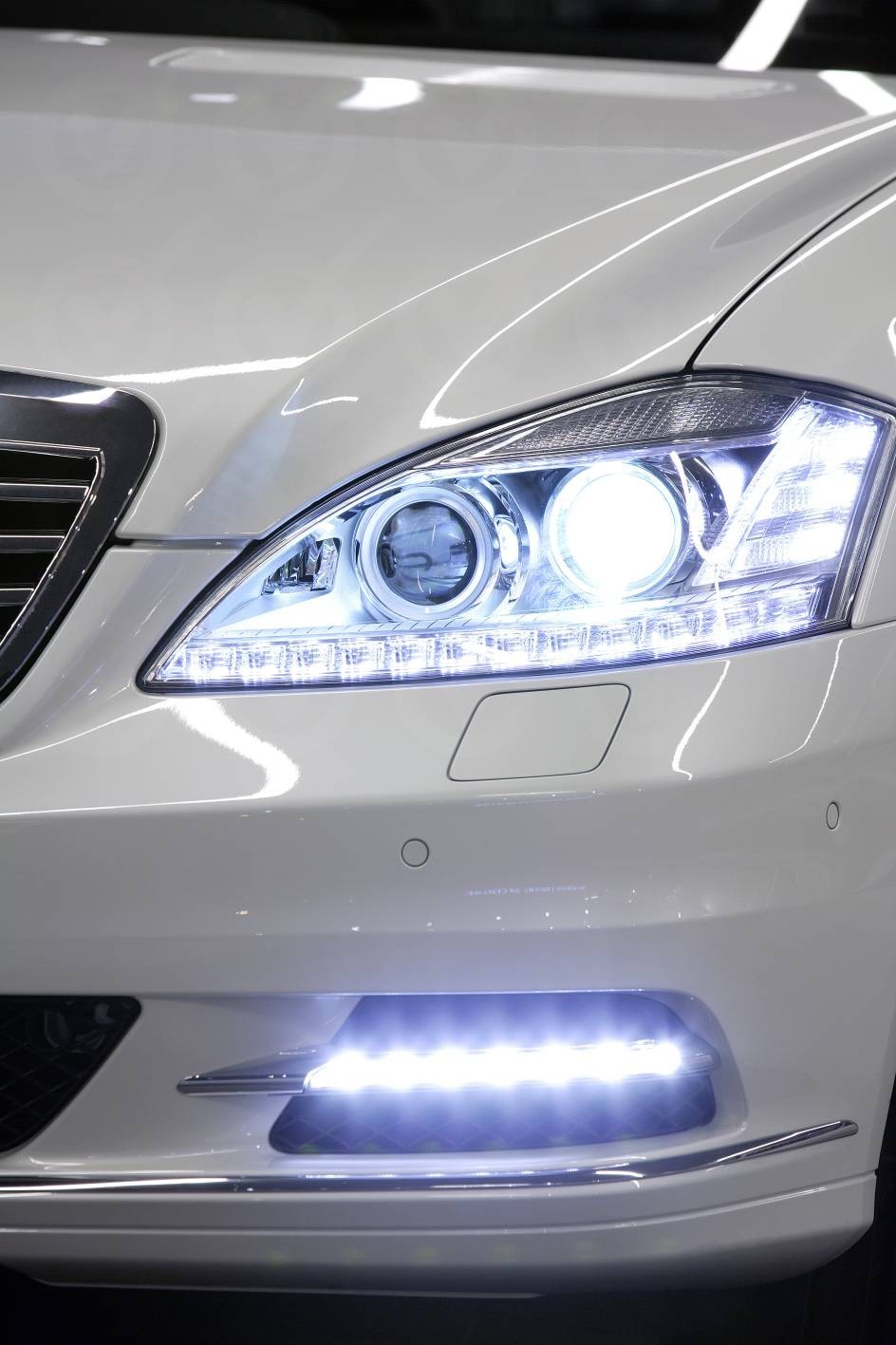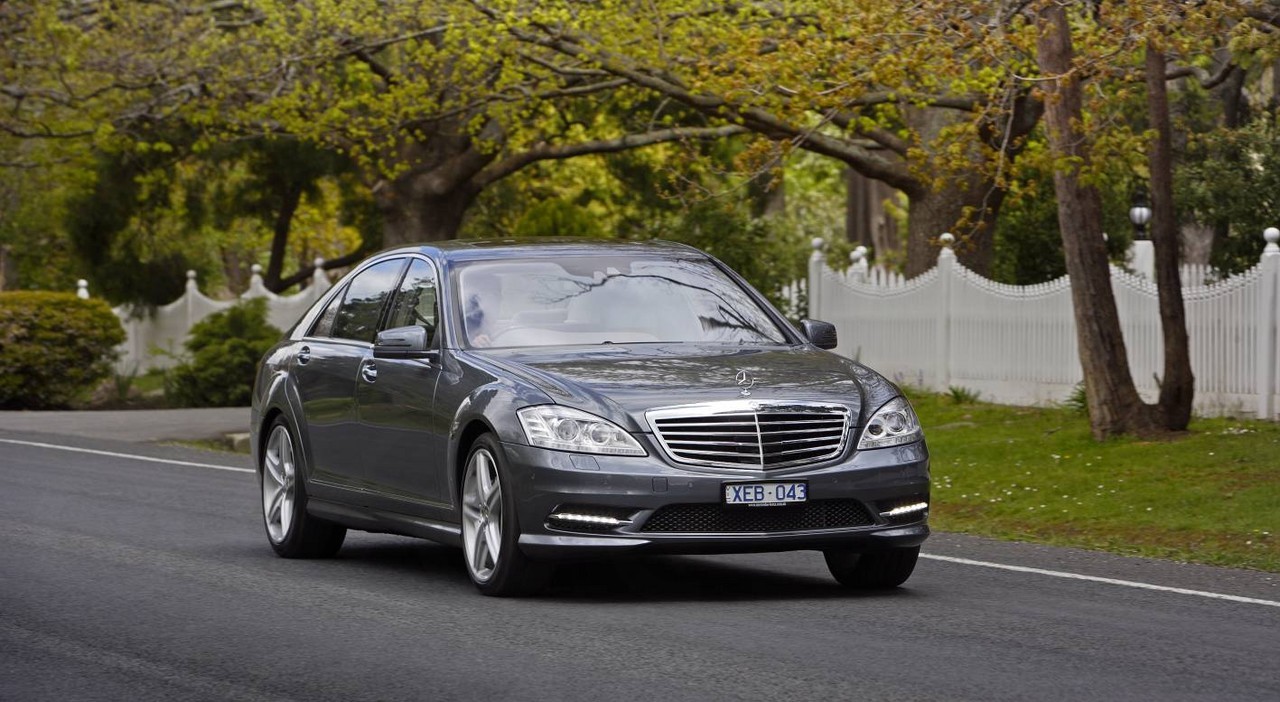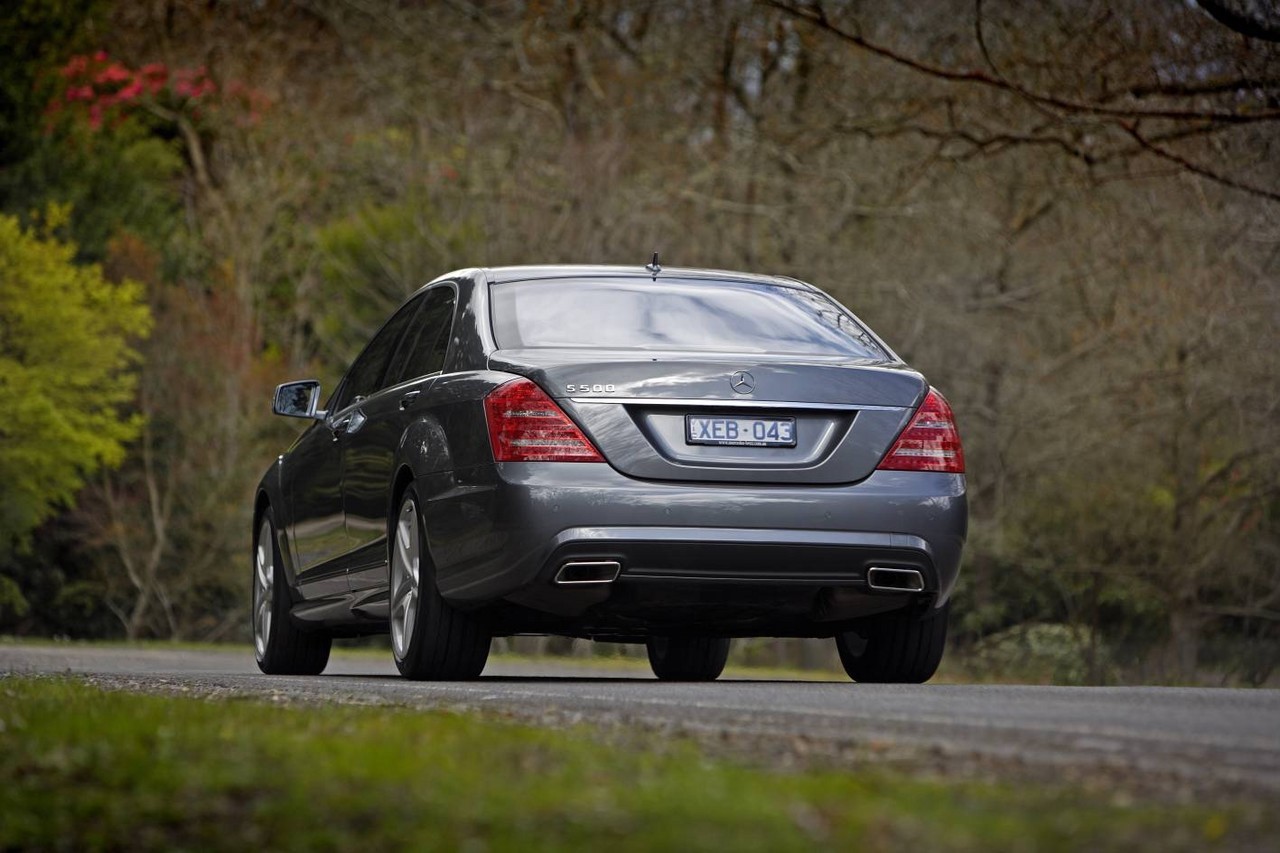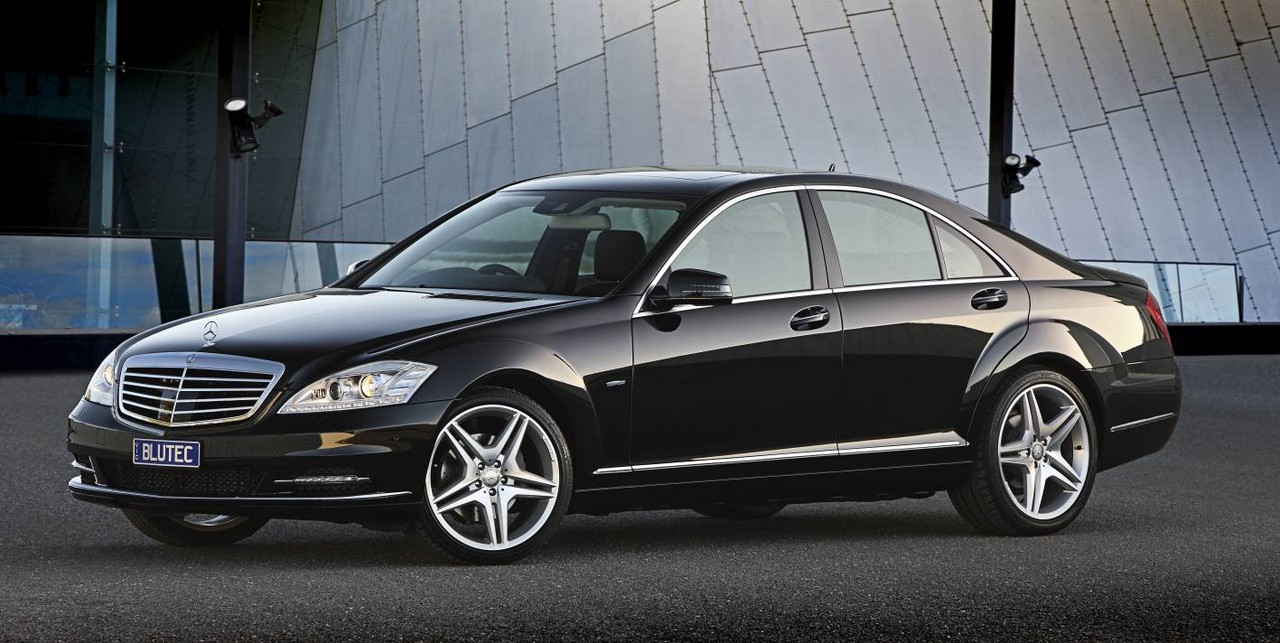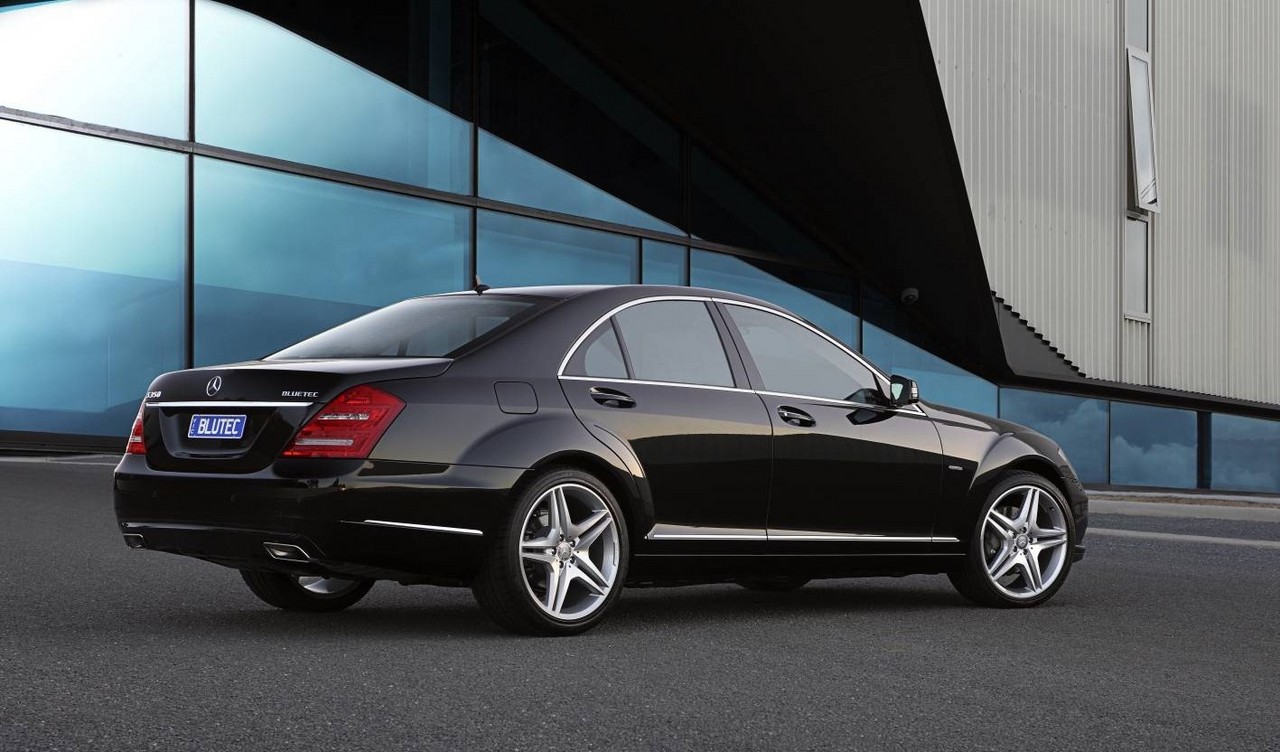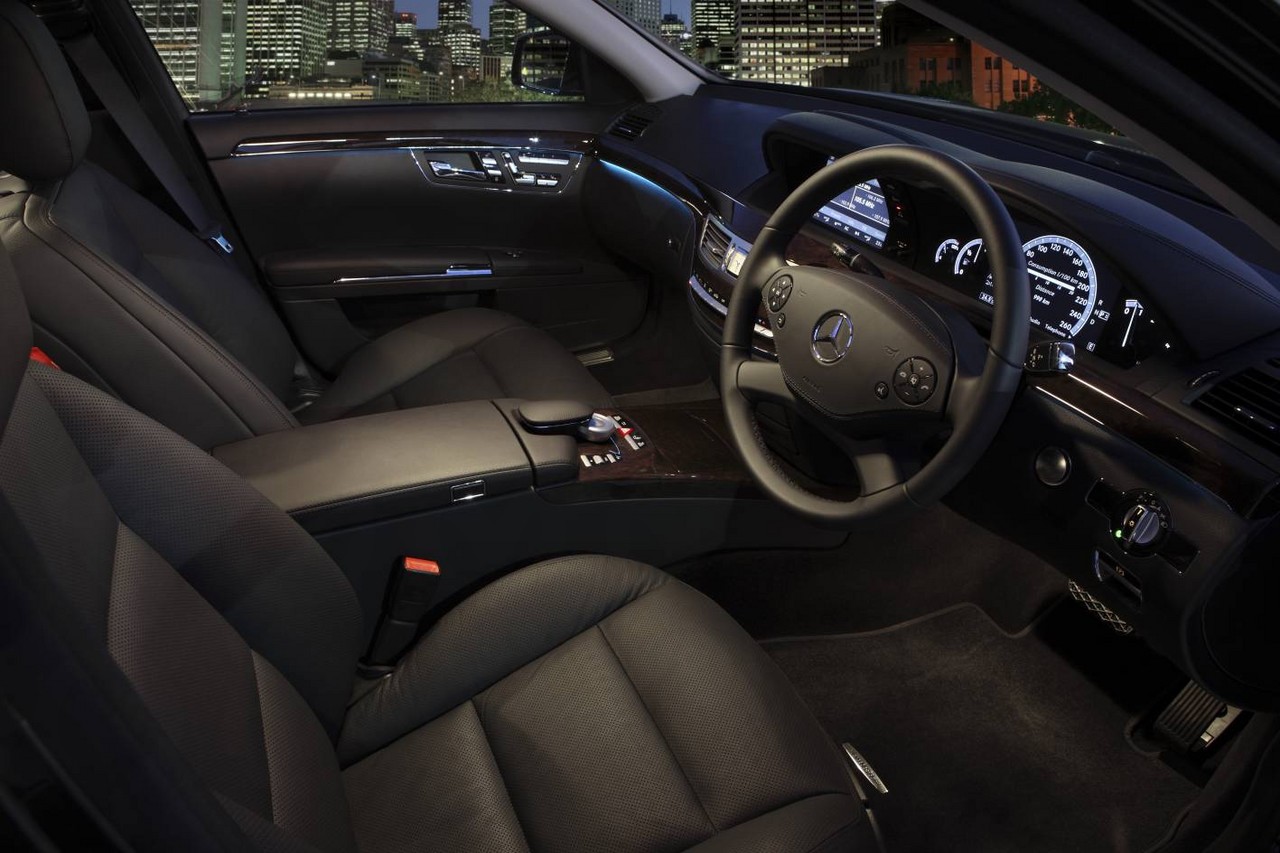
- Refined powertrains
- Comfortable ride with impressive dynamics
- Excellent standard of fit and finish
- Quiet, well-insulated cabin
- Air springs lack initial compliance on sharp bumps
- Overly assisted steering lacks feel
- M272 and M273 engines susceptible to balancer shaft failure
- Pre-2010 OM642 turbo-diesel engine susceptible to oil cooler leaks
Mercedes-Benz W221.I and V221.I S-Class (2006-09)
Overview
Released in Australia in February 2006, the W221 and V221 S-Class were prestige sedans with standard and long wheelbases, respectively. Manufactured in Sindelfingen, Germany, the W221/V221 S-Class range initially consisted of the S 500, but was subsequently expanded with the introduction of the S 350 (March 2006), S 600 (May 2006), S 450 (2007) and S 320 CDI (May 2008).
Please note that the Mercedes W221 S 63 and V221 S 65 AMG have been reviewed separately.
| W/base | Years | Engine | Trans. | Peak power | Peak torque | |
|---|---|---|---|---|---|---|
| S 320 CDI | SWB | 2008-09 | 3.0-litre turbo-diesel V6 (OM642) | 7sp auto | 173 kW at 3600 rpm | 540 Nm at 1600-2400 rpm |
| S 350 | SWB, LWB |
2006-09 | 3.5-litre petrol V6 (M272) | 7sp auto | 200 kW at 6000 rpm | 350 Nm at 2400-5000 rpm |
| S 450 | SWB, LWB |
2007 | 4.7-litre petrol V8 (M273) | 7sp auto | 250 kW at 6000 rpm | 460 Nm at 2700-5000 rpm |
| S 500 | SWB, LWB |
2006-09 | 5.5-litre petrol V8 (M273) | 7sp auto | 285 kW at 6000 rpm | 530 Nm at 2800-4800 rpm |
| S600 | LWB | 2006-09 | 5.5-litre twin-turbo petrol V12 (M275) | 5sp auto | 380 kW at 5000 rpm | 800 Nm at 1800-3500 rpm |
Dimensions and body
Compared to the W220 S-Class , the W221 S-Class was 38 mm longer (at 5076 mm), 16 mm wider (1871 mm), 29 mm taller (1473 mm) and had a 70 mm longer wheelbase (3035 mm). Compared to the standard W221, the long wheelbase V221 S-Class had a 130 mm longer wheelbase (3165 mm) and total length (5206 mm).
Relative to their predecessors, the W221 chassis achieved a 12 per cent increase in static torsional rigidity. Inside, the W221 S-Class featured a new ‘Direct Select’ lever on the right of the steering column which provided electronic control of the automatic transmission and replaced the centre console gear lever.
Suspension
The Mercedes-Benz W221/V221 S-Class had multi-link air suspension front and rear. With the exception of the S 600, S 63 AMG and S 65 AMG models, W221/V221 S-Class models were also fitted with Mercedes-Benz’s ‘AIRMATIC DC’ semi-active air suspension and Adaptive Damping System (‘ADS’) which automatically adjusted the shock absorbers to the road surface conditions and offered selectable ‘comfort’ and ‘sport’ configurations. The S600, however, was fitted with conventional coil springs and Mercedes-Benz’s ‘Active Body Control’ system which utilised hydraulic servo cylinders in the suspension struts, sensors and microprocessors to provide an adaptive suspension system which minimised pitch and body roll.
Safety equipment
Standard safety equipment for the Mercedes-Benz W221.I and V221.I S-Class included dual front airbags, front and rear side airbags, full-length curtain airbags, ABS, electronic brake force distribution, brake assist, electronic stability control, traction control, active front seat head restraints and front and outer rear seatbelts with pre-tensioners and load limiters. The PRE-SAFE system would also tension the front seat belts, inflate the air cushions in the multicontour seats and close the sunroof and windows if open in emergency situations (emergency braking or an imminent skid).
As standard, the S-Class was also fitted with Mercedes-Benz’s ‘Brake Assist Plus’, used a 24 GHz radar sensor with a range of 30 metres and a 77 GHz radar sensor with a range of 150 metres to monitor the distance to the vehicle ahead and would warn the driver if there was a risk of a collision. Brake Assist Plus could detect vehicles when travelling at speeds up to 200 km/h, and stationary objects when the driver was travelling at 7 km/h to 72 km/h. Significantly, Brake Assist Plus could calculate the necessary brake force assistance to prevent a rear-end collision, build up that pressure in the braking system and provide it as soon as the brake pedal was depressed for ‘the best possible deceleration’. Furthermore, the adaptive brake lights would also flash during emergency braking situations to warn traffic behind.
As standard, the Mercedes-Benz V221 S 600 was fitted with ‘Night View Assist’, which utiltised two infra-red headlights and an infra-red camera on the inside of the windscreen to record the reflected image of the road ahead – over 150 metres away – and display the image in the instrument cluster. From December 2006, the S 600 was also fitted with ‘Distronic Plus’, an ‘adaptive cruise control’ system which combined 24 GHz radar sensors which had a range of around 30 metres and a 77 GHz radar which had a range of 150 metres. Operating at speeds up to 200 km/h, Distronic Plus used an electronic control unit to analyse the information from both radar systems to calculate the engine, automatic transmission and braking parameters required for proximity control. As such, Distronic Plus could automatically apply the brakes to prevent the vehicle from becoming too close to traffic ahead (the time interval could be specified) and accelerate back to the set speed when traffic allowed. To accelerate from rest, the driver only needed to operate the Distronic stalk on the steering column or briefly depress the accelerator pedal. With Distronic Plus, automatic deceleration of up to four (4) m/s2was possible. If Distronic Plus detected that heavier braking was required, a warning light would illuminate in the instrument cluster and be accompanied by an audible warning. Furthermore, the electronic proximity control system could be activated independently of Distronic Plus at speeds over 30 km/h to alert the driver if they were approaching another vehicle too rapidly.
Features: Mercedes-Benz S 350 and S 320 CDI
Standard features for the Mercedes-Benz S 350 and S 320 CDI included 17-inch alloy wheels, COMAND (Cockpit Management and Data System) with colour display, a fourteen speaker sound system, six-disc CD/DVD player, memory card port (for PCMCIA cards), hard drive-based satellite navigation, voice recognition (‘Linguatronic’), TV tuner and telephone, dual-zone climate control air conditioning, leather upholstery, 12-way power adjustable front seats with, cruise control, front and rear fog lights, directional bi-xenon headlights with washer jets, front and rear parking sensors, automatic headlights, rain-sensing wipers and self-closing windows, power sunroof, remote central locking, power windows and mirrors, a power adjustable steering column (height and reach), folding and automatically dipping mirrors on reverse, an anti-glare rear view mirror, power-operated park brake, tyre pressure and brake pad monitors, memory settings (front seats, mirrors, steering wheel), Calyptus wood trim, tinted glass, a cargo net, trip computer and an immobiliser. Long wheelbase models also fitted with a power-operated rear blind and power adjustable outer rear seats.
Features: Mercedes-Benz S 500 and S 600
Compared to the S 350 and S 320 CDI, the S 500 was further equipped with a Harmon/Kardon Logic7 surround sound system, heated and ventilated multi-contour front seats, a combination wood/leather steering wheel and dark burr walnut trim. The S 500 L was differentiated by its ‘Artico’ synthetic leather dashboard.
The S 600 was distinguished by its 18-inch alloy wheels, four zone climate control air conditioning, dynamic multi-contour front seats with massage function, heated and ventilated rear seats, ‘Exclusive Passion’ leather upholstery, cruise control, a reversing camera, keyless go with remote starting, a remotely closing bootlid and alarm with tow-away and motion sensors. As noted above, the S 600 was also fitted with ‘Distronic Plus’ from December 2006.
August 2007: Mercedes-Benz S-Class update
In August 2007, standard features were improved to include a 3D display for the satellite navigation system and a glovebox auxiliary input socket (3.5mm/USB/iPod). Furthermore, the S 350 and S 350 L – and subsequently released S 320 CDI and S 320 CDI L – were fitted with ventilated and heated multi-contour front seats; the S 500 and S 500 L received Night View Assist, a reversing camera and a remotely closing bootlid.
Brochures
- Brochure: Mercedes-Benz W221/V221 S-Class (International) (August 2005)
- Brochure: Mercedes-Benz W221/V221 S-Class (International) (April 2008)
Related links
- Press Kit: Mercedes-Benz W221/V221 S-Class – safety development (August 2005)
- Press Kit: Mercedes-Benz W221/V221 S-Class – new engines (August 2005)
- Technical Data: Mercedes-Benz W221.I S 320 CDI (May 2008)
Mercedes-Benz W221.II and V221.II S-Class (2009-11)
Overview
Released in October 2009, the Mercedes-Benz W221 and V221 Series II (W221.II and V221.II) S-Class range introduced improved equipment levels, fuel economy and subtle visual updates. ‘Torque Vectoring Brake’ was also introduced across the range, braking the inside rear wheel when cornering to improve handling. Fuel economy was also improved through the introduction of lower rolling resistance tyres and modifications to the 7G-Tronic automatic transmission, steering and fuel pumps.
Visually, the W221.II and V221.II S-Class could be identified by the LEDs in their head- and tail-lights, wider grilles and more pronounced front bumpers; the S 600 was also fitted with a three-bar grille (rather than four). Inside, S-Class had new trims and materials, a redesigned steering wheel, extended wood paneling and three ambient lighting colours (previously limited to one).
| W/base | Years | Engine | Trans. | Peak power | Peak torque | |
|---|---|---|---|---|---|---|
| S 350 CDI BE | SWB | 2009-11 | 3.0-litre turbo-diesel V6 (OM642) | 7sp auto | 173 kW at 3600 rpm | 540 Nm at 1600-2400 rpm |
| S 350 | SWB, LWB |
2009-11 | 3.5-litre petrol V6 (M272) | 7sp auto | 200 kW at 6000 rpm | 350 Nm at 2400-5000 rpm |
| S 500 | SWB, LWB |
2009-11 | 5.5-litre petrol V8 (M273) | 7sp auto | 285 kW at 6000 rpm | 530 Nm at 2800-4800 rpm |
| S 600 | LWB | 2009-11 | 5.5-litre twin-turbo petrol V12 (M275) | 5sp auto | 380 kW at 5000 rpm | 800 Nm at 1800-3500 rpm |
Safety equipment
Compared to their predecessors, standard safety equipment for the W221.II and V221.II S-Class was extended to include:
- Pre-Safe Brake (autonomous emergency braking): using two 24 GHz sensors behind the front bumper which had a range of 30 metres and a 77 GHz radar which had a range of 200 metres, Pre-Safe Brake operated at speeds between 30 km/h and 200 km/h, and at speeds below 70 km/h if the vehicle was approaching a stationary queue of traffic. Around 2.6 seconds before the anticipated moment of impact, an audible warning would sound and a red warning would appear in the tachometer. Around 1.6 before the calculated impact, the first stage of Pre-Safe Brake would initiate partial braking autonomously with around 40 per cent of the maximum braking power (approximately four (4) m/s2); the Pre-Safe occupant protections system would also be activated. If the driver then applied the brakes, maximum braking force would be made available. If the driver failed to react, Pre-Safe Brake would – in its second stage – initiate autonomous emergency braking (i.e. maximum braking power) around 0.6 seconds before the unavoidable collision to reduce the severity of the impact;
- Distronic Plus (previously limited to the post-December 2006 V221.I S 600). For the W221.II and V221.II S-Class, however, the long-range radar had a range of 200 metres (previously 150 metres);
- Driver fatigue monitoring (‘Attention Assist’);
- Lane departure warning; and,
- Blindspot warning systems.
Finally, Night View Assist – where fitted – was also upgraded to include a pedestrian warning (‘Night View Assist Plus’).
Features
Standard features for the Mercedes-Benz W221.II/V221.II were extended to include a fourteen speaker Harman Kardon Logic7 surround sound system, ‘Splitview’ central monitor (which could display different content to the driver and front passenger from the same monitor), USB and SD card interfaces, a 7.2GB hard-drive music register, a reversing camera with parking guidance, Bluetooth connectivity and ‘keyless go’ (i.e. proximity key and push-button start). The S 350 CDI, S 350 and S 500 were also fitted with 18-inch alloy wheels.
The Mercedes-Benz V221.II S 600 was fitted with am updated Active Body Control system which included crosswind stabilisation.
Brochure
Press Kit
Related links
- Press Kit: Mercedes-Benz W221.II and V221.II S-Class (May 2009)
- Press Kit: Mercedes-Benz S-Class – voice control system (August 2009)
Mercedes-Benz W221.III and V221.III S-Class (2011-13)
Overview
Released in February 2011, the W221 and V221 Series III (W221.III and V221.III) S-Class range introduced new engines and mechanical upgrades:
- The S 350 CDI BlueTec was fitted with a Euro VI emissions compliant engine with increased power and torque;
- The S 350 was fitted with a more powerful direct-injection V6 petrol engine; and,
- The S 500 BlueEfficiency was fitted with a 4.7-litre twin-turbo V8 engine.
| W/base | Years | Engine | Trans. | Peak power | Peak torque | |
|---|---|---|---|---|---|---|
| S 350 CDI BlueTec | SWB | 2011-13 | 3.0-litre turbo-diesel V6 (OM642) | 7sp auto | 190 kW at 3600 rpm | 620 Nm at 1600-2400 rpm |
| S 350 BE | SWB, LWB |
2011-13 | 3.5-litre petrol V6 (M276) | 7sp auto | 225 kW at 6500 rpm | 370 Nm at 3500-5250 rpm |
| S 500 BE | SWB, LWB |
2011-13 | 4.7-litre twin turbo petrol V8 (M278) | 7sp auto | 320 kW at 5250 rpm | 700 Nm at 1800-3500 rpm |
| S 600 | LWB | 2011-13 | 5.5-litre twin turbo petrol V12 (M275) | 5sp auto | 380 kW at 5000 rpm | 830 Nm at 1800-3500 rpm |
Safety equipment
Compared to their predecessors, standard safety equipment for the W221.III and V221.III S-Class was extended to include:
- Active Lane Keeping Assist, which used the stability control system to autonomously brake wheels on one side of the vehicle to keep prevent it from drifting into another lane; and,
- Active Blind Spot Assist, which would also autonomously brake wheels on one side of the vehicle to prevent collisions with objects outside the driver’s field of vision.
Features
Standard features for the W221.III and V221.III S-Class range were largely unchanged.
Brochure
Related links
